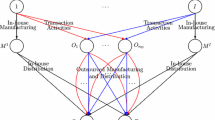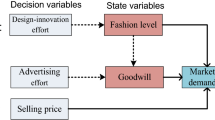Abstract
In this paper we model the design quality competition in durable product markets. We use a duopolistic non-cooperative game theoretic framework. Each firm controls the design quality level and the price of its product. The resulting control theoretic model is solved under certain functional assumptions to describe the Nash equilibrium design quality and pricing strategies of the two competitors. We compare open and closed loop design quality and pricing strategies. We use an extensive set of numerical experiments to investigate the effects of various parameters of the model on the optimal policies. We conclude with a brief summary of our results and some useful managerial insights derived from the model.
Similar content being viewed by others
References
Juran, J.M. and Gryna, F.M. Jr. (1980) Quality planning and analysis, in Product Development Through Usage, 2nd edn., McGraw Hill, New York.
Montgomery, D.C. (1985) Introduction to Statistical Quality Control, John Wiley, New York.
Crosby, P.B. (1979) Quality is Free, McGraw Hill, New York.
Crosby, P.B. (1984) Quality Without Tears, McGraw Hill, New York.
Deming, W.E. (1982) Quality, productivity and competitive position. Technical Report, MIT Center for Advanced Engineering, Cambridge MA.
Halpin, J.F. (1966) Zero Defects: A New Dimension in Quality Assurance, McGraw Hill, New York.
Lee, H.L. and Tapiero, C.S. (1986) Quality control and the sales process. Naval Research Logistics Quarterly, 33, 569–587.
Tapiero, C.S. and Lee, H.L. (1989) Quality control and product servicing: a decision framework. European Journal of Operational Research, 39, 261–273.
Kacker, R.M. (1986) Off-line quality control, parameter design and the Taguchi method. Journal of Quality Technology, 17, 176–88.
Taguchi, G. (1986) Introduction to Quality Engineering: Designing Quality into Products and Processes, Asian Productivity Organization, Tokyo.
Fine, C.H. (1986) Quality improvement and learning in production systems. Management Science, 10, 1301–15.
Garvin, D.A. (1988) Managing Quality, Free Press, New York.
Nelson, P. (1974) Advertising as information. Journal of Political Economy, 82, 729–754.
Gaimon, C. (1988) Simultaneous and dynamic price, production, inventory and capacity decisions. European Journal of Operational Research, 35, 426–441.
Gaimon, C. (1994) The price-production problem: an operations and marketing interface. Working Paper, School of Management, Georgia Institute of Technology, GA 30332–0520.
Pessemier, E.A. (1965) New Product Decisions, McGraw-Hill, New York.
Bass, F. (1989) A new product growth model for consumer durables. Management Science, 15, 215–222.
Kotler, P. (1990) Marketing Management: Analysis, Planning and Control, Prentice Hall, Englewood Cliffs, NJ, p. 260.
Garvin, D.A. (1992) Operations Strategy: Text and Cases, Prentice Hall, Englewood Cliffs, NJ.
Anon, (1990) Here come the hot new luxury cars, Fortune, April 28, 58–65.
Holt, D. and Mukundan, R. (1972) A Nash algorithm for a class of non-zero sum differential games. International Journal of Systems Sciences, 24, 379–387.
Fershtman, C. and Muller, E. (1984) Capital accumulation games of infinite duration. Journal of Economic Theory, 33, 322–339.
Gaimon, C. (1989) Dynamic game results of the acquisition of new technology. Operations Research, 37, 410–425.
Sethi, S.P. and Thompson, G. (1981) Optimal Control Theory: Application to Management Science, Nijho., Boston, MA.
Starr, A.W. and Ho, Y.C. (1969) Non-zero sum differential game. Journal of Optimization Theory and Applications, 3, 184–206.
Mukundan, R. and Elsner, W. (1975) Linear feedback strategies in non-zero sum di.erential game. International Journal of System Sciences, 6, 513–532.
Mangasarian, O.L. (1966) Sufficient conditions for the optimal control of nonlinear systems. SIAM Journal of Control, 4, 139–152.
Seierstad, A. and Sydsaeter, K. (1977) Sufficient conditions in optimal control theory. International Economic Review, 18, 367–391.
Kamien, M.I. and Schwartz, N.L. (1981) Dynamic Optimization: The Calculus of Variations and Optimal Control in Economics and Management, Elsevier North Holland, New York, p. 122.
Hax, A.C. and Majluf, N.C. (1984) Strategic Management, Prentice Hall, Englewood Cliffs, NJ.
Finnie, W.C. (1994) Hands on Strategy, John Wiley, New York.
Clark, K.B. and Fujimoto, T. (1991) Product Development Performance: Strategy, Organization, and Management in the World Auto Industry, Harvard Business School Press, Boston, MA.
Gaimon, C. (1988) The acquisition of new technology and its impact on a firm' competitive position. Annals of Operations Research, 15, 37–63.
Roth, A.V., Gaimon, C. and Krajewski, L. (1991) Optimal acquisition of FMS technology subject to technological progress. Decision Sciences, 22, 308–334.
Kouvelis, P. and Mukhopadhyay, S.K. (1995) Competing on design quality: a strategic planning approach for product quality with the use of a control theoretic model. Journal of Operation Management, 12, 369–385.
Mukhopadhyay, S.K. and Kouvelis, P. (1997) A differential game theoretic model for duopolistic competition on design quality. Operations Research, 45, 886–893.
Author information
Authors and Affiliations
Rights and permissions
About this article
Cite this article
Kouvelis, P., Mukhopadhyay, S.K. Modeling the design quality competition for durable products. IIE Transactions 31, 865–880 (1999). https://doi.org/10.1023/A:1007674616495
Issue Date:
DOI: https://doi.org/10.1023/A:1007674616495




